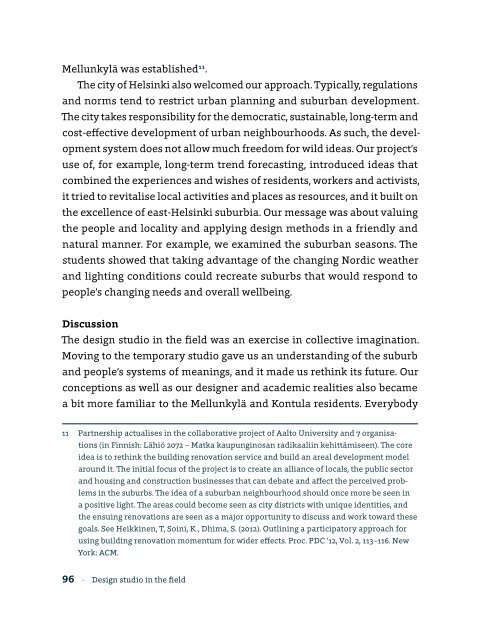Designing for wellbeing
Designing for wellbeing
Designing for wellbeing
Create successful ePaper yourself
Turn your PDF publications into a flip-book with our unique Google optimized e-Paper software.
Mellunkylä was established 11 .<br />
The city of Helsinki also welcomed our approach. Typically, regulations<br />
and norms tend to restrict urban planning and suburban development.<br />
The city takes responsibility <strong>for</strong> the democratic, sustainable, long-term and<br />
cost-effective development of urban neighbourhoods. As such, the development<br />
system does not allow much freedom <strong>for</strong> wild ideas. Our project’s<br />
use of, <strong>for</strong> example, long-term trend <strong>for</strong>ecasting, introduced ideas that<br />
combined the experiences and wishes of residents, workers and activists,<br />
it tried to revitalise local activities and places as resources, and it built on<br />
the excellence of east-Helsinki suburbia. Our message was about valuing<br />
the people and locality and applying design methods in a friendly and<br />
natural manner. For example, we examined the suburban seasons. The<br />
students showed that taking advantage of the changing Nordic weather<br />
and lighting conditions could recreate suburbs that would respond to<br />
people’s changing needs and overall <strong>wellbeing</strong>.<br />
Discussion<br />
The design studio in the field was an exercise in collective imagination.<br />
Moving to the temporary studio gave us an understanding of the suburb<br />
and people’s systems of meanings, and it made us rethink its future. Our<br />
conceptions as well as our designer and academic realities also became<br />
a bit more familiar to the Mellunkylä and Kontula residents. Everybody<br />
11 Partnership actualises in the collaborative project of Aalto University and 7 organisations<br />
(in Finnish: Lähiö 2072 – Matka kaupunginosan radikaaliin kehittämiseen). The core<br />
idea is to rethink the building renovation service and build an areal development model<br />
around it. The initial focus of the project is to create an alliance of locals, the public sector<br />
and housing and construction businesses that can debate and affect the perceived problems<br />
in the suburbs. The idea of a suburban neighbourhood should once more be seen in<br />
a positive light. The areas could become seen as city districts with unique identities, and<br />
the ensuing renovations are seen as a major opportunity to discuss and work toward these<br />
goals. See Heikkinen, T, Soini, K., Dhima, S. (2012). Outlining a participatory approach <strong>for</strong><br />
using building renovation momentum <strong>for</strong> wider effects. Proc. PDC ’12, Vol. 2, 113–116. New<br />
York: ACM.<br />
96 · Design studio in the field
















